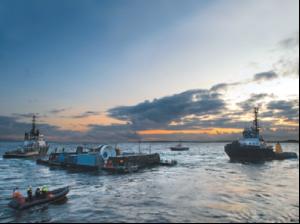

|
Edward Lowton
Editor |


|
| Home> | Plant, Process & Control | >Sensors and instrumentation | >Sensors aid tidal turbine development |
ARTICLE
Sensors aid tidal turbine development
25 January 2013
Non-contact torque sensors from Sensor Technology are used in the development of commercial-scale in-stream tidal turbines produced by OpenHydro. The company uses the sensors, which are based on surface acoustic wave

Non-contact torque sensors
from Sensor Technology are
used in the development of
commercial-scale in-stream tidal
turbines produced by OpenHydro.
The company uses the sensors, which are based on surface acoustic wave (SAW) technology, to accurately measure rotational speed and frictional forces in a simulator for the turbine bearings.
The simulator allows engineers to determine how frictional forces in bearings vary with different loads and rotational speeds. Central to this is the measurement of torque in a shaft from the motor that drives the bearing under test. TorqSense RWT3 series sensors provided a solution.
The units depend on SAW transducers that comprise two thin metal electrodes, in the form of interlocking 'fingers', on a piezoelectric substrate such as quartz.
Since the transducers operate at radio frequencies, it is easy to couple signals to them wirelessly. Hence TorqSense sensors can be used on rotating shafts, and can provide data continuously without the need for brushes and slip rings.
OpenHydro uses the RWT320 sensor in conjunction with Sensor Technology's TorqView software.
The company uses the sensors, which are based on surface acoustic wave (SAW) technology, to accurately measure rotational speed and frictional forces in a simulator for the turbine bearings.
The simulator allows engineers to determine how frictional forces in bearings vary with different loads and rotational speeds. Central to this is the measurement of torque in a shaft from the motor that drives the bearing under test. TorqSense RWT3 series sensors provided a solution.
The units depend on SAW transducers that comprise two thin metal electrodes, in the form of interlocking 'fingers', on a piezoelectric substrate such as quartz.
Since the transducers operate at radio frequencies, it is easy to couple signals to them wirelessly. Hence TorqSense sensors can be used on rotating shafts, and can provide data continuously without the need for brushes and slip rings.
OpenHydro uses the RWT320 sensor in conjunction with Sensor Technology's TorqView software.
MORE FROM THIS COMPANY
- Pay as you sense proves popular
- British engineering used in test rig
- Developing technologies
- Heli-hook helps raise angel
- Torquing up success at Formula Student
- Simple solution aids SOLAS compliance
- New wireless torque technology
- Test rig technology that talks the torque
- Pumps are in for a testing time
- Talking the torque
OTHER ARTICLES IN THIS SECTION

















